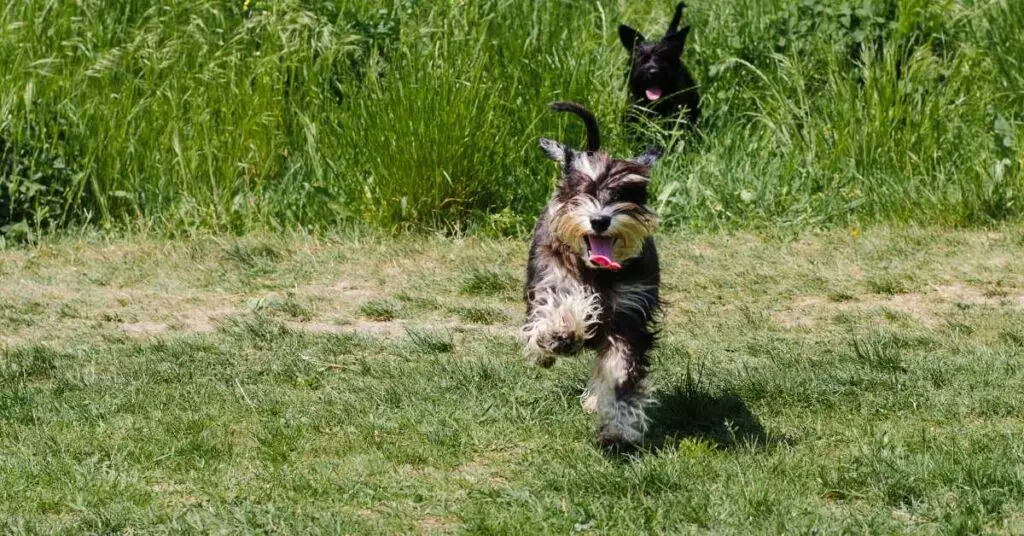Are you the proud owner of a lively and intelligent Schnauzer? If so, you know firsthand the joy and companionship they bring to your life. But have you ever wondered, ‘How often should I walk my Schnauzer?’
Well, just like a painter skillfully selects their brushstrokes to create a masterpiece, you must carefully choose the frequency of your Schnauzer’s walks to ensure their physical and mental well-being. Regular exercise is crucial for Schnauzers, as it helps them burn off excess energy, maintain a healthy weight, and prevent behavioral issues.
In this article, we will explore the factors that influence your Schnauzer’s exercise needs, the importance of establishing a daily walking routine, and how to tailor walks to your Schnauzer’s specific health conditions. By following these guidelines, you’ll not only provide your Schnauzer with the exercise they require but also create a stronger bond and sense of belonging between you and your furry companion.
Key Takeaways
- Schnauzers require regular exercise for their physical and mental well-being.
- It is recommended to walk a Schnauzer at least once a day for a minimum of 30 minutes.
- Every dog is unique, and their energy requirements may vary.
- Regular exercise helps Schnauzers burn off excess energy and maintain a healthy weight.
Understanding Your Schnauzer’s Exercise Needs
Understanding your Schnauzer’s exercise needs is crucial in order to provide them with the appropriate amount of physical activity. Schnauzers are active and energetic dogs that require regular exercise to maintain their physical and mental well-being. It is recommended to walk your Schnauzer at least once a day for a minimum of 30 minutes. However, every dog is unique, and their energy requirements may vary.
Some Schnauzers may need more exercise, while others may be content with less. Regular exercise not only helps to burn off excess energy, but it also provides numerous benefits for your Schnauzer, including weight management, improved cardiovascular health, and mental stimulation.
Additionally, exercise is a great opportunity for you and your Schnauzer to bond and strengthen your relationship. So, make sure to prioritize your Schnauzer’s exercise needs to keep them happy and healthy.

Factors to Consider: Energy Levels and Age
You’d be surprised at just how lively and energetic your schnauzer can be, especially considering their age and energy levels. Monitoring your schnauzer’s energy levels is crucial in determining how often and how long you should walk them.
Younger schnauzers tend to have higher energy levels and require more exercise, while older ones may not have the same stamina. It’s important to strike a balance between keeping them active and not overexerting them. As a general guideline, aim for at least 30 minutes to an hour of exercise daily for adult schnauzers.
Puppies and younger schnauzers may need more frequent walks throughout the day, with shorter durations to prevent exhaustion. Remember to pay attention to your schnauzer’s cues and adjust their exercise routine accordingly.
By tailoring the duration and frequency of their walks to their energy levels and age, you’ll ensure they stay happy, healthy, and well-exercised.
The Importance of Regular Exercise for Schnauzers
Staying active is crucial for keeping your schnauzer happy and healthy. Regular exercise not only helps to burn off excess energy but also provides numerous benefits for your furry friend.
Here are four reasons why regular exercise is essential for schnauzers:
- Physical health: Regular exercise helps to maintain a healthy weight, improve cardiovascular health, and strengthen muscles and joints.
- Mental stimulation: Exercise provides mental stimulation, preventing boredom and reducing the risk of destructive behaviors such as excessive barking or chewing.
- Bonding time: Walking your schnauzer regularly creates an opportunity for quality bonding time, strengthening your relationship and sense of belonging with your furry companion.
- Behavior control: Regular exercise helps to release pent-up energy, reducing the likelihood of behavioral issues such as hyperactivity or aggression.
Understanding your schnauzer’s exercise requirements and providing them with regular exercise will not only keep them physically fit but also contribute to their overall well-being and happiness.
Creating a Daily Walking Routine
To truly determine the benefits of a daily walking routine for your schnauzer, let’s explore the theory that regular exercise can significantly improve their overall health and well-being.
Creating a walking schedule for your schnauzer is essential to ensure they receive the right amount of exercise each day. Schnauzers are an active breed that requires physical activity to prevent weight gain and keep their muscles strong.
A daily walking routine provides numerous benefits for your furry friend. It helps to maintain a healthy weight, strengthens their cardiovascular system, and improves joint flexibility. Additionally, walking provides mental stimulation, reducing the chances of boredom and destructive behavior.
By incorporating a daily walking routine into your schnauzer’s life, you can enhance their overall quality of life and create a stronger bond between you and your beloved pet.
Tailoring Walks to Your Schnauzer’s Health Conditions
Make sure to consult with your veterinarian to tailor your walks to your schnauzer’s specific health conditions and needs. This is especially important if your schnauzer has joint issues. Walking is still beneficial for dogs with joint problems, but it’s important to make some adjustments to ensure their comfort and safety.
Here are a few tips to consider:
- Incorporate interval training into your walks. Short bursts of higher intensity exercise followed by periods of rest can help build strength and endurance without putting too much strain on your schnauzer’s joints.
- Choose softer surfaces for walking, such as grass or dirt paths, to minimize impact on the joints.
- Avoid steep inclines and stairs, as these can put extra stress on the joints.
- Consider using a harness instead of a collar to reduce strain on the neck and spine.
- Monitor your schnauzer for any signs of discomfort during and after the walk, and adjust the duration and intensity accordingly.
By tailoring your walks to your schnauzer’s specific needs, you can ensure they stay active and healthy while minimizing any discomfort or risk of injury.
Adjusting Exercise Levels for Puppies and Senior Schnauzers
Now that you understand how to tailor walks to your Schnauzer’s health conditions, it’s important to consider the specific needs of puppies and senior Schnauzers when it comes to exercise. Adjusting exercise levels is crucial for these two age groups to ensure their well-being and longevity.
For puppies, it’s essential to provide them with enough exercise to burn off their abundant energy. Aim for short, frequent walks throughout the day to prevent overexertion. As they grow, gradually increase their exercise duration and intensity.
On the other hand, senior Schnauzers may have reduced mobility and energy levels. It’s important to be mindful of their limitations and adjust their exercise accordingly. Short, gentle walks can help maintain their joint flexibility and muscle tone without causing strain.
By understanding and adapting to the exercise needs of puppies and senior Schnauzers, you can ensure they stay healthy and happy throughout their lives.
Incorporating Mental Stimulation into Walks
Enhance your Schnauzer’s walks by adding a sprinkle of mental stimulation, turning each stroll into a delightful treasure hunt for their curious minds. Incorporating mental stimulation into walks is a great way to keep your Schnauzer engaged and mentally sharp.
One way to do this is by using leash training techniques that encourage your dog to explore their surroundings and use their senses. For example, you can incorporate scent games into your walks by hiding treats or toys along the way, allowing your Schnauzer to use their nose to search for them.
Another option is to vary your walking routes, taking your Schnauzer to different places each time to expose them to new sights, sounds, and smells. This will keep them mentally stimulated and prevent boredom.
Remember, mental exercise is just as important as physical exercise for your Schnauzer’s overall well-being.
Tips for Keeping Your Schnauzer Safe During Walks
Be sure to prioritize the safety of your furry friend during walks by keeping them on a secure leash and being aware of their surroundings at all times. Here are some tips for keeping your Schnauzer safe during walks:
- Use a sturdy leash: Invest in a high-quality leash that’s comfortable for both you and your Schnauzer. This will ensure that your dog is secure and won’t break free during the walk.
- Practice leash training: Train your Schnauzer to walk calmly on a leash by using positive reinforcement techniques. This’ll help prevent them from pulling or darting off unexpectedly.
- Be cautious of your surroundings: Pay attention to your surroundings and watch out for potential hazards such as traffic, other dogs, or unsafe areas.
- Introduce new walking equipment gradually: If you’re planning to use new walking equipment like a harness or a head collar, introduce it slowly and make sure your Schnauzer is comfortable with it before going on a walk.
- Carry identification: Always make sure your Schnauzer has proper identification tags or a microchip in case they accidentally wander off.
By following these tips, you can ensure that your Schnauzer stays safe and enjoys their walks to the fullest.
Exploring Different Walking Routes and Environments
Venture through various verdant paths and vibrant vistas to invigorate your walks with a Schnauzer. Exploring scenic routes won’t only provide a change of scenery but also stimulate your Schnauzer’s senses. Look for trails that wind through lush parks, along waterfronts, or into wooded areas. These routes will offer different sights, sounds, and smells, keeping your furry friend engaged and excited.
Additionally, consider finding walking buddies for your Schnauzer. Dogs are social creatures, and walking with other canines can enhance their overall experience. Joining a local dog walking group or organizing playdates with friends who own dogs can create a sense of community and belonging for both you and your Schnauzer.
So, lace up your shoes, grab your Schnauzer’s leash, and embark on a journey of discovery and companionship.
Socializing Your Schnauzer through Regular Walks
Embarking on regular walks with your Schnauzer will not only provide exercise but also foster socialization with other dogs and humans. Schnauzers are known to be social and friendly dogs, and going for walks is a great way to expose them to different environments and experiences.
By taking your Schnauzer for regular walks, you’re giving them the opportunity to interact with other dogs and humans, which helps them build confidence and learn proper social behavior. This socialization is essential for their overall well-being and can prevent behavioral issues in the future.
Additionally, walking your Schnauzer in different places allows them to encounter new scents, sights, and sounds, stimulating their senses and keeping them mentally engaged. So, make sure to schedule regular walks for your Schnauzer to enjoy the numerous benefits of socialization and exercise.
Signs That Your Schnauzer Needs More or Less Exercise
If your Schnauzer is constantly restless, zooming around the house, and bouncing off the walls, it may be a sign that they need more exercise. These energetic little dogs require regular physical activity to keep them mentally and physically stimulated.
Signs of overexercising can include excessive panting, difficulty breathing, and reluctance to continue walking. On the other hand, signs of underexercising may manifest as weight gain, destructive behavior, and excessive barking. It is important to strike a balance and provide your Schnauzer with an appropriate amount of exercise based on their age, health, and energy level.
A good starting point is to aim for at least 30 minutes of brisk walking twice a day, but always consult with your veterinarian for personalized advice. Remember, a well-exercised Schnauzer is a happy and well-behaved companion!
Consulting with a Veterinarian for Personalized Exercise Recommendations
Make sure to schedule a visit with your veterinarian to get personalized exercise recommendations that will keep your furry friend healthy and happy. Consulting with a veterinarian is crucial in determining the appropriate exercise regimen for your schnauzer.
Every dog is unique, and factors such as age, weight, and overall health must be considered. Your veterinarian will assess your schnauzer’s individual needs and provide you with tailored exercise recommendations. They’ll take into account any specific requirements or restrictions your dog may have.
Whether it’s daily walks, playtime, or more intense activities, your vet will guide you in finding the right balance. Remember, regular exercise is essential for your schnauzer’s physical and mental well-being. By consulting with a veterinarian, you can ensure that your furry companion receives the personalized exercise plan they need to thrive.
Frequently Asked Questions
Can I take my Schnauzer for a walk immediately after meals?
Taking your schnauzer for a walk immediately after meals may pose potential risks. It’s best to wait at least 30 minutes to prevent digestive issues. Prioritize your schnauzer’s well-being and opt for walks before or in between meals instead.
How long should each walk be for my Schnauzer?
Each walk for your Schnauzer should ideally be around 30 minutes to an hour. It is recommended to walk your Schnauzer at least once or twice a day to ensure they get enough exercise and mental stimulation.
Can I use a retractable leash for my Schnauzer?
Yes, you can use a retractable leash for your schnauzer, but be cautious of retractable leash safety. Consider alternatives like a standard leash or a hands-free leash for better control and safety during walks.
Are there any specific exercises or activities I can do with my Schnauzer indoors?
Engage your schnauzer’s mind and body with fun indoor games. Play hide-and-seek, teach new tricks, or use puzzle toys to provide mental stimulation. These activities will keep your furry friend entertained and strengthen your bond, ensuring a sense of belonging.
Can I take my Schnauzer for a walk in extreme weather conditions?
To keep your schnauzer safe during extreme weather conditions, it’s best to avoid walking them in harsh conditions such as extreme heat, cold, or heavy rain. Instead, find indoor activities to keep them active and entertained.
Conclusion
In conclusion, it’s essential to understand the exercise needs of your schnauzer and provide them with regular walks to keep them healthy and happy.
One interesting statistic to note is that the average schnauzer requires at least 30 minutes to an hour of exercise every day. By tailoring your walks to their energy levels and health conditions, exploring different routes and environments, and socializing them through regular walks, you can ensure that your schnauzer receives the right amount of exercise.
Remember to consult with a veterinarian for personalized exercise recommendations for your furry friend.







